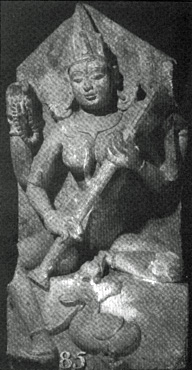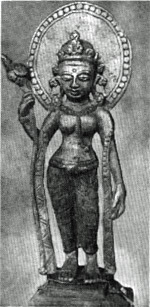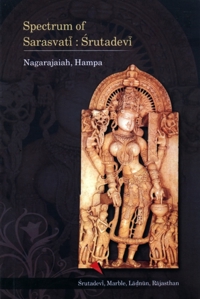The image, measuring 57 cm (22V£ inches) in height, and made of mottled red sand-stone, is interesting not only an account of its early date but also for its different stylistic idiom which has no parallel. Though its head, left breast and shoulder are missing, the image has preserved the spirit of an ancient tradition. The crescent folds of her sari covers left shoulder and suspends to conceal her waist. The dedicatory inscription,in seven lines on the two-tiered rectangular pedestal, specifying the date of its installation in Brāhmi Characters, states:
'Success! In the year 54, 4th month of winter 4, on the 10th day, on the lunar day specified as above, one statue of Sarasvatī, the gift of the Smith Gova, son of Sīha, made at the instance of the preacher, Vācaka Āryya-Deva Sraddhacaro (companion) of the gaṇin Āryya (Venerable) Māghahasti, the pupil of the preacher Āryya (G) Hasta(u)hasti, from Koṭṭiya gaṇa, the Shānīya kula, the Vairā śākhā and the Śrīgriha sambhoga, has been set up for the welfare of all beings. In the avatala my stage dancer' [Smith: 1901: 54].
The image in Kuṣāṇ style, flanked by two male figures, is devoid of ornaments. She is holding a palm-leaf manuscript wrapped in cloth (or with a wood-cover depicting zigzag design) in her left hand. Though what she held in her right arm is difficult to decide, the surviving beads of rosary confirm that she was holding a rosary. Goddess is seated not in the usual lalitāsana, but on her haunches in godohikāsana, with knees spread wide apart, 'squatting posture', is rare and symbolizes the aptitude of Jaina monks and householders towards reading and writing from the hoary past. The person standing on her right flank holds a water pot, wears a short pleated dhoti with his hair combed back, is the donar Gova, son of Sīha. The other male standing on her left, clothed as a friar with hands clasped in veneration, is Āryadeva vācaka, preacher of the donor who was a lohakāruka, 'ironsmith'.
Thus, the oldest known image of goddess Sarasvatī is in fact of Jaina affiliation. She 'is depicted squatting, in the same position in which (Vardhamāna) Mahāvīra attained enlightenment, with a sacred book in her hand, indicative even at that early stage of her position as the tutelary deity of the Jain scriptures and the deity who is invoked for help to dispel the darkness of concealing Karma' [Paul Dundas: The Jains: 214].
However, Catherine Ludvik, discussing extensively, differs in dating this earliest image and does not agree with the suggestion of assigning 132 CE: T myself will cautiously settle for a date of ca. third century for our Kaṅkālī Tīlā Sarasvatī image' [Ludvik 233]. Albeit, this is the first Sarasvatī in anthropomorphic form in sculpture, and its historical significance needs no exaggeration. This image could be regarded as the precursor of later Sarasvatī images with the inclusion of more elaborate sculptural compositions which adore hundreds of masonry Jain temples.
The other two images from Mathurā belong to the seventh and tenth century respectively:
 |  |
| [11] Mathurā, 7th cent. Indian Museum, Kolkata | [12] Mathurā, 10th cent. |
 |
| [13] Ākoṭā, early 7th cent. |
Ākotā (Añkottaka), a small suburban village near Baroda or Vaḍodara (Vaṭapatra), an ancient Jaina seat, has yielded many Jaina metal images. Among the pre-eighth century Sarasvatī images, the three Akoṭa Bronzes of the seventh century are noted for their antiquity and quality:
-
The 26.67 cm Bronze (600-20 CE) is a pious gift of Isiyā nun (ganinī).
-
The 31.24 cm image in tribhanga, 'three-bend posture', also of the seventh century.
-
The 13.46 cm seventh century image stands in tribhanga (similar to the above).
 |
| [14] Vasanthgaḍh / Piṇḍavārā,7th cent. |
All the above images are holding sanāla-padma, 'long stemmed lotus', in their right hand. Iconography and identification of these three Bronzes has been discussed by Umakanth P. Shah.
The 39.37 cm Vasanthgaḍh (Rajasthan) Sarasvatī (650-75) image is, stylistically similar to the images from Ākoṭā (Gujarat). She holds book in her left hand, and sanāḷa-padma in her right arm. She stands atop a pedestal and wears an elaborate crown made of projections. This image has been shifted to the Mahāvīrasvāmi temple in Pindawāḍā (Rajasthan).
Albeit, Sarasvatī has an unique place in the Jaina tradition from ab initio to ad finim. The Vividha-tīrtha-kalpa of Jinaprabhasūri (14th century), and the Ācāradinakara of Vardhamānasūri (1415 CE) have recorded her form: "Śrutadevatā (Jaina Sarasvatī) is white, puts on white garments and rides on a haṁsa. Rays of light radiate from her person and she sits on a white lion-throne. She is four-armed: the two left hands hold the white lotus and the vīṇā, and the two right carry the book and the rosary of pearls" [Shah 2011. It may be recalled that holding the usual attribute of akṣasūtra and padma are traditionally associated with Brahma. Sarasvatī is always depicted with a single face though the number of arms may vary from two to sixteen. Worship of two and six -armed Sarasvatī is widely prevalent among the Buddhists.
 |
| [15] Ākoṭā, early 7th cent. |
Sarasvatī "is accorded an extraordinary place of honour with a special epithet of Śrutadevī, 'the canon-goddess', or 'goddess of scripture', whose brilliantly chiselled sculptures that belong to the early centuries of current era are extant. Her images are enshrined and adorned in all sects of Jainism.". [Hampana: 2007: 63].
The special feature of Sarasvatī is that she presides over the teachings of all the 24 Jinas. In the sui generis image of Deogadh she stands in triple flexion, shows her right hand in varadākṣa mudrā, 'charity-rosary posture', and carries a lotus in the raised left hand. Remarkably the images of Tīrthaṅkaras are carved on Sarasvatī's right, left and top. Evidently, she is Śrutadevī, and her special features will be discussed in the next chapter. Two monks in the flank and two devotees near her feet are worshipping her. Four female attendants of her retinue suggest deity's status.
Similarly the standing image of Sarasvatī in triple flexion in temple no. 19(18) at Deogadh is magnificent and an inscription on the figure states "Viracandra's disciple was Tribhuvanakīrti. This name was bestowed as a fitting one because he was dedicated to pious works.
 |
| [16] Jina - Samyukta, Devagaḍh, 11th century |
N.N. was the splendour of the full moon in the sky of the Mathura-patanvaya. His son was the thakur Siraka who had a wife called Mohini. She was a river formed by the stream of the waters of virtue. She was a bee on the foot-lotuses of the monks of the Jina. She was called 'Mohini' because she had brought into confusion the minds of all intelligent people by virtue of her loyalty to her husband. This lady donated the goddess Padmāvatī who bestows the desired success. Written by pandit Gopala in samvat 1126." [Klaus Bruhn 207]. The deity stands on her graceful pose and ornaments on her body are tastefully displayed.
From the early centuries of the current era Sarasvatī sculptures are extant. She is mentioned as the deity of wisdom, intelligence, music, and all arts in the Angavijjā, Bhagavatīsūtra and Vimalasūri's the Paumacariya (472> CE). Many references come from Jaina narrative literature in Prakrit, Sanskrit, Kannada, Gujarati and Rajasthani languages where Vidyādevatās are invoked for help in mastering vidyāmantrās, magical powers. Hence ṣoḍaśa (16) Mahāvidyādevīs are connected with magical invocation. The Jaina Cosmology and Pantheon has conceived a collective body of sixteen Vidyādevis which is entirely different from the conception of Sarasvatī / Śrutadevī.
The genesis of these goddesses can be traced to ancient texts. The Rūpamaṇḍana lists only two names -Mahāvidyā and Sarasvatī (5.61). The Pradhānika-Rahasya mentions ten names and their forms - Mahāvidyā, Mahāvāṇi, Bhāratī, Vāk, Sarasvatī, Āryya, Brāhmi, Kāmadhenu, Vedagarbha, and Dhiśvari. The Devatāmūrti-prakaraṇam (8.79-85) lists twelve Vidyās -Mahāvidyā, Mohinī, Bhāratī, Sarasvatī, Āryā, Brāhmi, Mahādhenu, Vedagarbha, Īsvari, Mahālaksmi, Mahākāli and Mahāsarasvatī. The Dīpārṇava (17.1-15) also lists the same twelve with slight variations in their names.
Ākoṭā (Gujarat), C. 600-20, Bronze, 26.67 cm Museum & Picture Gallery, Baroda, courtesy: U.P. Shah.
Vasanthgaḍh - Piṇḍawāḍā (Rajasthan), metal image, C. 650-75, courtesy: U.P. Shah. An oblong aureole behind the head shows her divinity.
 Prof. Dr. Nagarajaiah Hampana
Prof. Dr. Nagarajaiah Hampana
